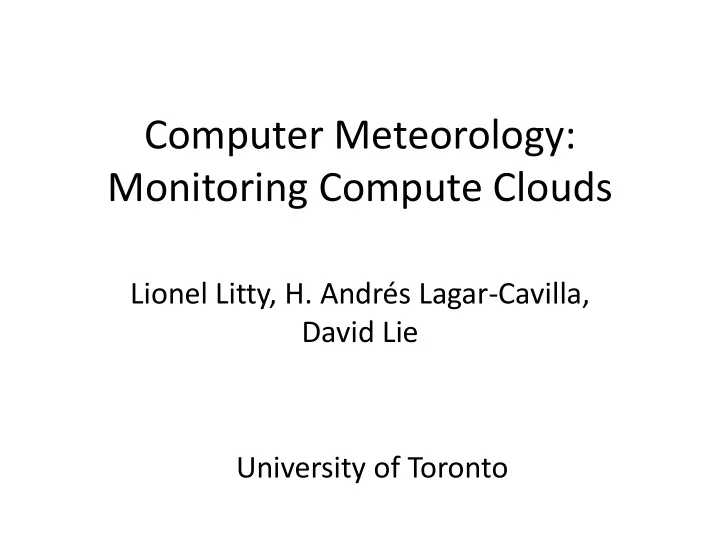

Computer Meteorology: Monitoring Compute Clouds Lionel Litty, H. Andrés Lagar-Cavilla, David Lie University of Toronto
Infrastructure as a Service (IaaS) Examples: -Amazon EC2 -GoGrid -Mosso - … Customer Customer Customer Virtual Machine Virtual Machine Virtual Machine Cloud provider infrastructure 2 of 21
3 of 21
Security • Miscreants can abuse the cloud provider’s resources: – Spam. – Use infrastructure to attack other computers. – Hosting illegal content. • This has consequences for the cloud provider: – Damage to reputation. – Technical consequences: Shared IPs blacklisted. – Potential legal concerns. 4 of 21
Solutions? Network monitoring (NM) has limitations: • Encrypted traffic • Stealthy malicious traffic Distributed attack using botnet. 5 of 21
ISPs use NM and have done poorly. Unlike ISPs, cloud providers control the execution platform: Can they use this to their advantage? 6 of 21
Introspection Process Process Process Virtual Machine VM’s OS Reductionist approach: understand a complex system by understanding its parts. • Identify processes. • Analyze the behavior of each process. 7 of 21
Non-malicious and Malicious VMs • Non-malicious: may be vulnerable, not yet compromised. • Malicious: under miscreant control. – Attacker can blur boundaries between processes. • Tamper-evident monitor: – Either report accurate information – Or report that it cannot obtain accurate information. 8 of 21
Introspection properties • Power Can it see everything? • Robustness Is it resilient to changes in the monitored system? • Unintrusiveness Can it negatively impact the monitored system? 9 of 21
Host agent Customer VM Power Process Process Host Robustness agent Unintrusiveness VM’s OS VMM Cloud provider infrastructure 10 of 21
Host agent w/ driver Customer VM Power Process Process Host Robustness agent Unintrusiveness VM’s OS Driver VMM Cloud provider infrastructure 11 of 21
Trap & Inspect Customer VM Power Process Process Process Robustness Traps Unintrusiveness Traps VM’s OS Introspect VMM ion code Cloud provider infrastructure 12 of 21
Checkpoint & Rollback Customer VM Power Process Process Process Robustness Traps Unintrusiveness Traps VM’s OS Introspect VMM ion code Cloud provider infrastructure 13 of 21
Architectural Introspection Customer VM Power Process Process Process Robustness Unintrusiveness VM’s OS Introspect VMM ion code Cloud provider infrastructure 14 of 21
Summary of introspection approaches Power Unintrusiveness Robustness Host agent Good Poor Good Host agent w/ Best Worst Poor driver Trap & Inspect Best Best Worst Checkpoint & Best Best Poor Rollback Architectural Poor(?) Best Best monitoring 15 of 21
Introspection example • Goal: – Which applications are run by a customer VM? – What’s the version of these applications? • Why? – Detect malicious code – Inform customer of vulnerable code – Deploy vulnerability-specific filters 16 of 21
Execution monitoring • Goal: Identify all running binary code in a VM. • Examples – Host agent: /proc, Process Explorer – Trap & inspect: examine OS data structures – Architectural monitoring: leverage MMU to identify all executing code 17 of 21
Execution monitoring Customer VM Process Process Process Page fault VM’s OS VMM 18 of 21
File monitoring • Goal: What byte code is Java executing? What about the PHP interpreter? • Examples: – Host-based: strace, filemon – Trap & inspect: examine OS data structures – Architectural monitoring: taint-tracking? 19 of 21
File Monitoring Customer VM Process Process Process VM’s OS Script VMM 20 of 21
Conclusion • Architectural introspection should be used when possible. • More research is needed to explore the range of events that can be monitored using Architectural introspection. • Cloud providers should be mindful of the limitations of introspection. 21 of 21
Recommend
More recommend